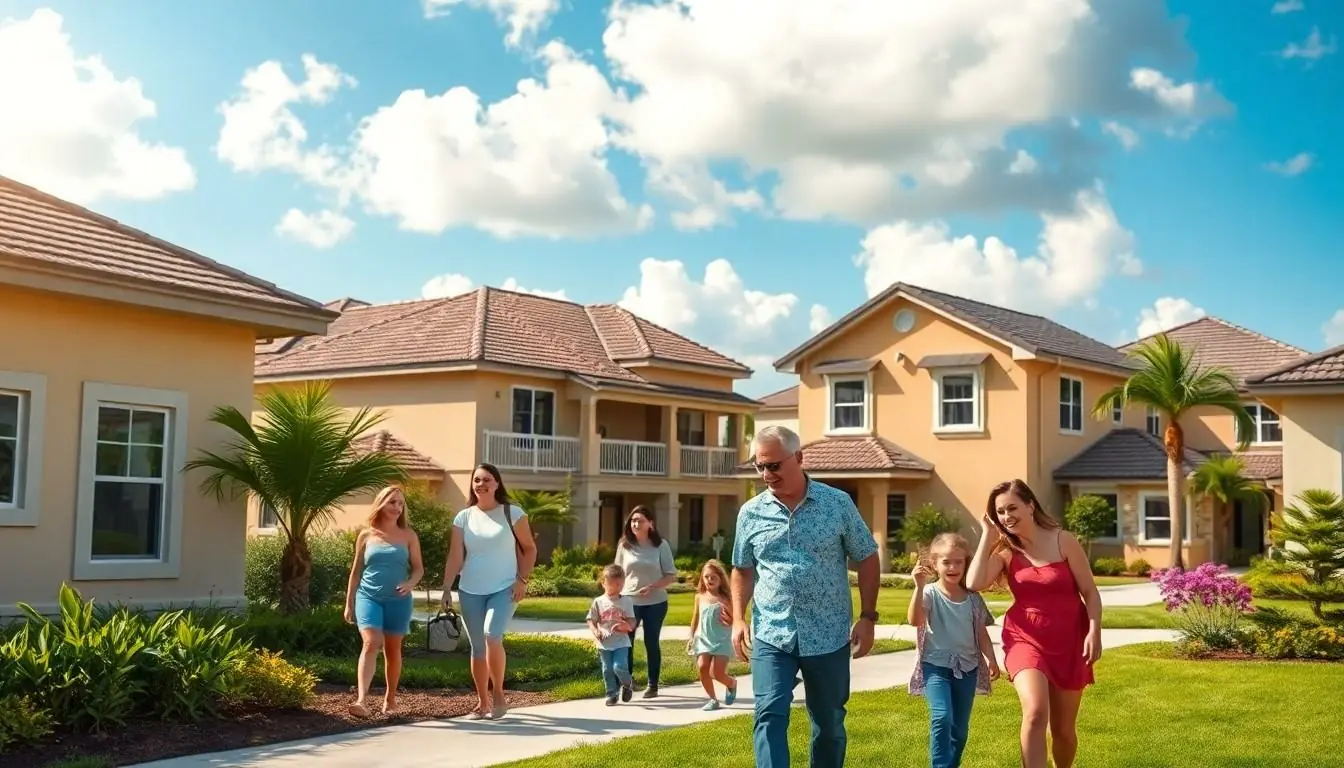Florida’s real estate market is like a rollercoaster ride—thrilling, unpredictable, and sometimes a bit dizzying. With sunny skies, sandy beaches, and a population that just keeps growing, it’s no wonder everyone wants a piece of the Sunshine State. Whether it’s retirees trading snow shovels for flip-flops or young families seeking adventure, Florida’s charm is hard to resist.
Table of Contents
ToggleOverview of Florida Real Estate Market Trends
Florida’s real estate market demonstrates consistent growth, characterized by increasing home prices and construction activity. Recent data indicates a 10% rise in median home prices year-over-year, reflecting strong demand across various regions. Investors find opportunities in both residential and commercial sectors, with urban areas like Miami, Orlando, and Tampa seeing significant developments.
High demand leads to a limited inventory, contributing to competitive bidding situations. Homes often sell above listing price, showcasing buyers’ urgency to secure properties. The state attracts new residents, with approximately 900 new people relocating each day, resulting in a robust market for both single-family homes and condos.
Luxury real estate remains a strong segment, especially in coastal areas. Waterfront properties command premium prices, appealing to buyers seeking vacation homes or investment opportunities. As remote work trends persist, many professionals opt for spacious homes in suburban settings, further influencing market dynamics.
Interest rates affect purchasing power, with recent increases slightly slowing buyer activity. Nevertheless, the overall market retains resilience, as Florida’s favorable climate and lifestyle continue to draw interest. Investors monitor emerging neighborhoods for growth potential, as these areas often offer more affordable options for first-time buyers.
Sellers benefit from current trends, experiencing faster sales and enhanced profit margins. With demand consistently outpacing supply, the outlook for Florida’s real estate market remains optimistic. Local economies thrive on real estate activity, contributing to the state’s overall appeal as a destination for living and investment.
Factors Influencing the Market

Various elements shape Florida’s real estate landscape, impacting buyer behavior and market dynamics.
Economic Conditions
Economic factors play a crucial role in the real estate market. Current statistics indicate a robust job market, showcasing a low unemployment rate of around 3.4%. This positive economic environment supports increased consumer spending and confidence. Real estate investment thrives amid favorable conditions, encouraging builders to embark on new projects. Inflation and interest rate changes can affect mortgage rates and purchasing power. Despite recent increases, demand remains strong, reflecting an underlying resilience in the market. Positive economic outlooks in sectors like tourism and technology also bolster housing demand.
Population Growth
Population growth significantly influences the Florida real estate market. An influx of approximately 900 new residents moving to the state daily creates high demand for housing. This trend appeals especially to retirees seeking warm climates and families desiring better living conditions. Urban areas, such as Miami, Orlando, and Tampa, are witnessing heightened developments due to this population surge. Builders respond with new construction, aiming to meet the needs of diverse demographic groups. Increased population density often leads to a rise in both residential and commercial real estate investment. Overall, growth patterns directly correlate with the evolving housing landscape.
Current Market Conditions
Florida’s real estate market continues to experience significant changes. Recent data highlights vital trends affecting buyers and sellers alike.
Home Prices
Home prices in Florida have increased consistently, with a notable 10% year-over-year rise in median values. Increased demand fuels this upward trend as new residents flock to the state. On average, homes now sell for more than their listing price due to competitive bidding wars. Coastal luxury properties remain particularly sought after, attracting buyers looking for vacation homes or lucrative investments. Many urban areas, like Miami and Orlando, exhibit even steeper price trends, reflecting local popularity and lifestyle appeal. Alongside this growth, affordability concerns may arise, especially for first-time buyers navigating the evolving market landscape.
Inventory Levels
Inventory levels in Florida’s housing market remain low, contributing to fierce competition among buyers. The limited stock of available homes prompts bidding wars, often leading to multiple offers on single listings. As approximately 900 new residents relocate daily, builders are responding with increased construction activity. However, the pace of new developments may not fully satisfy current demand. In urban areas, this challenge is more pronounced, as families and individuals seek homes. The combination of high demand and low inventory creates a complex environment for buyers, where swift decisions become essential to secure properties.
Future Predictions for Florida Real Estate
Florida’s real estate market maintains a trajectory of growth, reflecting its appeal to a diverse population and favorable living conditions. With ongoing trends indicating strong demand, the outlook for both short and long-term market conditions remains positive.
Short-Term Trends
Strong demand persists in the short term, influenced by a steady influx of new residents. Home prices continue to rise, driven by competitive bidding wars, particularly in urban areas. Builders respond to this urgency by ramping up construction. Limited inventory propels homes to sell above listing prices, creating urgency among buyers. Economic factors, including the current low unemployment rate of around 3.4%, support continued investment and confidence in the housing market.
Long-Term Outlook
Long-term predictions suggest sustained growth for Florida’s housing market. Increased job opportunities in sectors like technology and tourism bolster population growth. A robust real estate landscape encourages further investment and new developments. As more residents seek the lifestyle Florida offers, demand for housing remains high. Builders may struggle to keep pace with construction needs, especially in urban centers where demand is greatest. While potential fluctuations in interest rates pose challenges, the overall forecast for Florida’s real estate market, characterized by ongoing demand and economic vitality, appears bright.
Florida’s real estate market continues to thrive amidst changing dynamics and increasing demand. The state’s allure remains strong with its favorable climate and vibrant lifestyle attracting new residents daily. Competitive bidding and rising home prices reflect the urgency in securing properties, particularly in urban areas.
While builders are responding to the demand with new construction, challenges persist in keeping pace with the rapid influx of buyers. The outlook for Florida’s real estate remains optimistic with job growth and economic stability supporting ongoing investment. As the market evolves, those looking to buy or invest should stay informed and ready to act in this competitive landscape.



